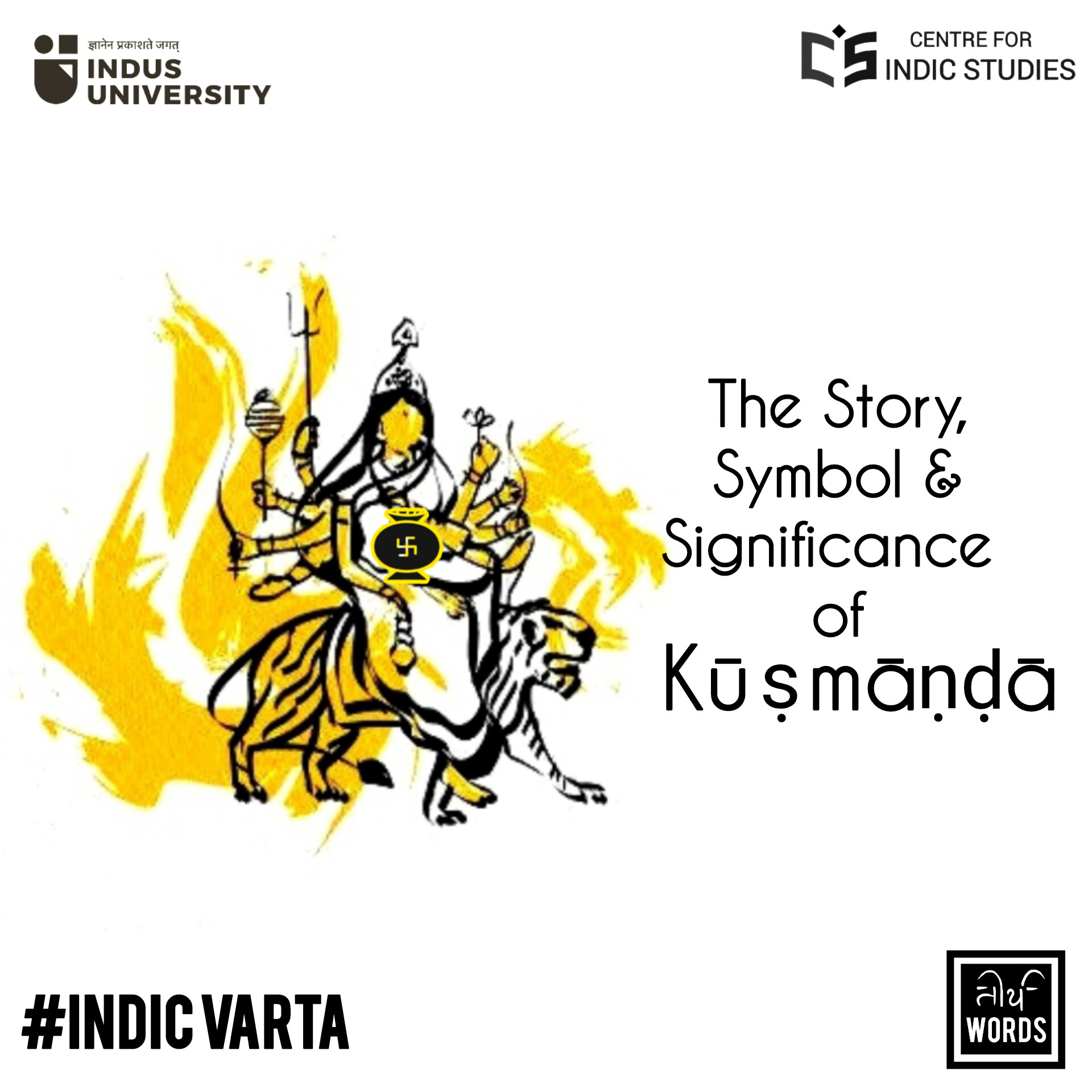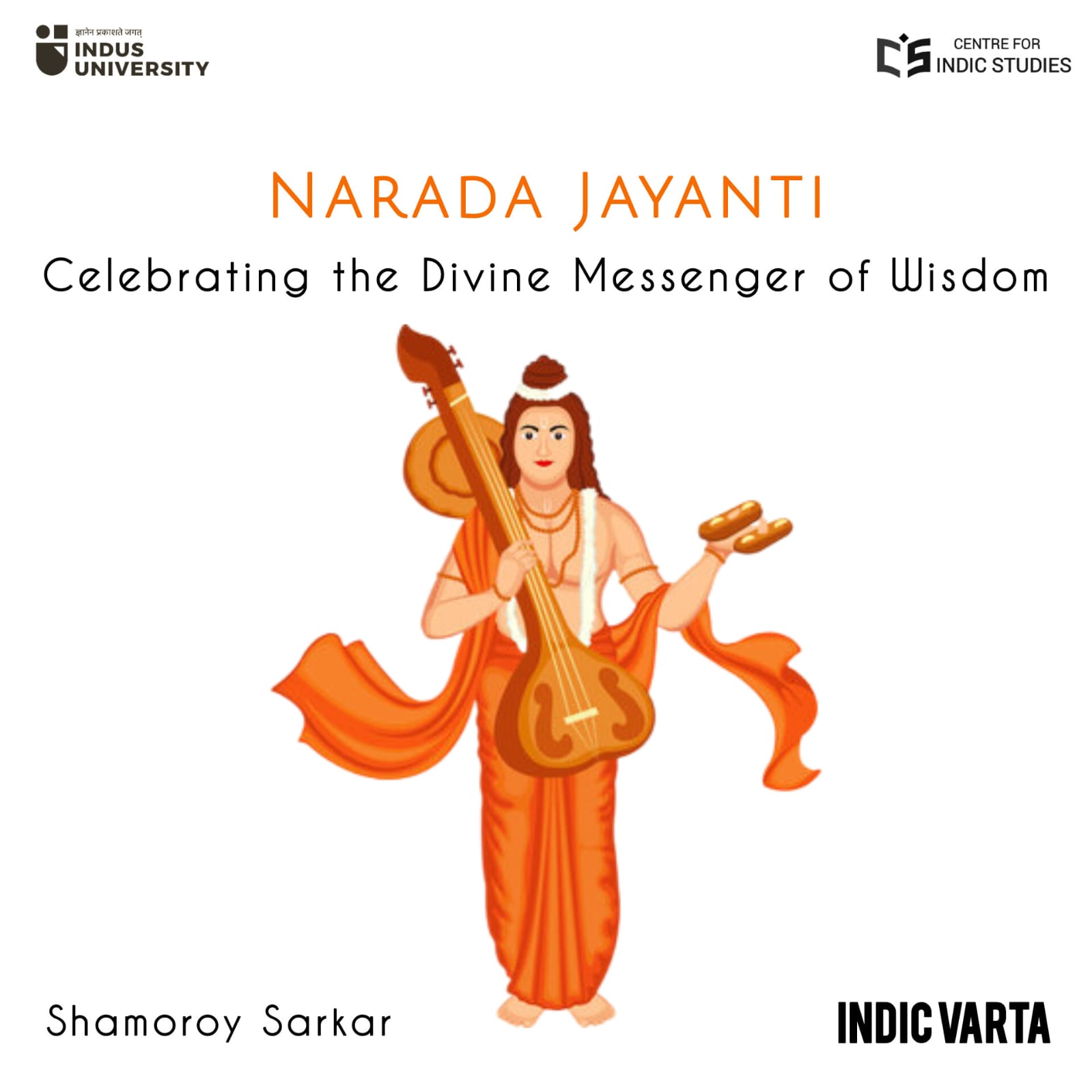- Visitor:147
- Published on: 2024-10-06 05:50 pm
The Story, Symbol, and Significance of Kūṣmāṇḍā
The tale of Kūṣmāṇḍā might be the most panoramic allegory that describes how the cosmos was conceived by the amalgamation of the primordial matter and the primordial consciousness. Thus, the figure of Kūṣmāṇḍā may also be studied from the perspective of cosmology and astrophysics apart from the theological musings attached to her.

Story
So, the devī was married to Śiva— the cosmic feminine was reunited with the cosmic masculine! A pleasant daughter to a prosperous wife, she was now ready to tread upon the greatest phase of a woman’s life— motherhood! Indeed, motherhood is the bedrock of womanhood itself! What else can make a woman the most loving and venerable at the same time than her motherly instinct? So, the devī’s cosmic genitalia called the prakṛti was churned and seeded by Śiva’s masculine liṅga called the puruṣa— out of which emerged the cosmic egg from which creation itself emerged! Impregnated, the devī was to hold the embryo of the cosmos in her womb.
All the gods, deities, and ethereal beings genuflected before her and hooted in joy to celebrate the creation! They presented to the goddess a golden urn full of amṛta, the ambrosia of eternal joy, and conferred upon her the novel nomenclature of Kūṣmāṇḍā as she held the vessel. Goddess Kūṣmāṇḍā sat upon her mount tiger and shine bright with all her armaments with which she would always protect the cosmos. She smiled at everyone and blessed all as a mother does!
Symbol
The tale of Kūṣmāṇḍā might be the most panoramic allegory that describes how the cosmos was conceived by the amalgamation of the primordial matter and the primordial consciousness. Thus, the figure of Kūṣmāṇḍā may also be studied from the perspective of cosmology and astrophysics apart from the theological musings attached to her. The urn of amṛta which she holds in her hands very symbolically hints at the idea of the eternal sustenance of creation which may only be converged by the cyclical nature of the cosmos. The figure of Kūṣmāṇḍā encapsulates the essence of creation, embodying the fusion of material existence with the metaphysical realm. At the heart of this allegory is the image of Kūṣmāṇḍā holding an urn filled with amṛta, the nectar of immortality. This potent symbol is a profound representation of the eternal sustenance that supports all forms of life and the ongoing cycles of creation and destruction within the universe. In many ways, this urn serves as a microcosm of the universe itself— holding within it the potential for life, regeneration, and continuity. Just as the cosmos experiences cycles of birth, decay, and rebirth, the amṛta signifies the sustaining force that nurtures existence across these transformations.
From a cosmological standpoint, the narrative of Kūṣmāṇḍā prompts us to consider the origins of the universe through the lens of both matter and consciousness. In modern astrophysics, we explore concepts such as the Big Bang, where the universe emerged from an infinitesimal point of singularity. This initial event can be likened to the primordial matter from which Kūṣmāṇḍā arises, suggesting that the essence of creation is deeply embedded in the fabric of reality itself. The tale challenges us to reflect on how consciousness—often seen as a secondary phenomenon—plays an equally vital role in the shaping of the universe. In this way, Kūṣmāṇḍā stands as a bridge between the material and the metaphysical, inviting a holistic view of existence.
Moreover, the cyclical nature of the cosmos, integral to the narrative of Kūṣmāṇḍā, resonates with various scientific models that describe the universe's evolution. Theories such as cosmic inflation and oscillating models suggest that the universe undergoes phases of expansion and contraction, paralleling the cyclical themes found in the mythological tale. This cyclical perspective not only informs our understanding of the universe but also enriches our spiritual and philosophical reflections on life itself.
The story of Kūṣmāṇḍā, therefore, transcends mere allegory; it becomes a rich tapestry of interconnected themes that beckons deeper exploration. Her figure embodies a synthesis of creation and preservation, emphasizing that life is not a linear journey but rather a continuous cycle of experiences that feed into one another. This perspective aligns with many indigenous and ancient philosophies that view life as a web of relationships, where each element—be it a star, a planet, or a living being—plays an essential role in the grand design.
The figure of Kūṣmāṇḍā encapsulates a holistic view of existence that bridges spirituality, cosmology, and philosophy. By examining her story, we uncover insights that encourage us to contemplate upon the mysteries of life and the cosmos. The urn of amṛta not only symbolizes the sustenance of creation but also invites us to reflect on our own roles within this vast, interconnected universe. As we explore these themes, we are reminded that the essence of life is an eternal journey— one of growth, transformation, and the relentless pursuit of understanding in an ever-evolving cosmos.
Kūṣmāṇḍā is also a symbol of fertility and motherhood. She represents the vitality of procreation and the phase of pregnancy in a woman’s life. Kūṣmāṇḍā embodies not only cosmic creation but also serves as a profound symbol of fertility and motherhood. In many cultures, motherhood is revered as a source of life, and Kūṣmāṇḍā personifies this vital energy. Her nurturing essence reflects the sacred aspects of procreation, highlighting the transformative journey of pregnancy, which is a time of profound change and growth. Just as the cosmos undergoes cycles of birth and renewal, so too does a woman's body adapt and flourish during this miraculous phase.
The figure of Kūṣmāṇḍā reminds us of the deep connection between the divine and the human experience of motherhood. She represents the creative forces that allow life to emerge, emphasizing the importance of nurturing and protection. In her presence, the act of giving birth is not just a biological function; it becomes a spiritual journey, one that celebrates the power and resilience of women.
Moreover, Kūṣmāṇḍā's symbolism extends beyond physical fertility. She encapsulates the emotional and psychological dimensions of motherhood, embodying the unconditional love, strength, and sacrifice that define the maternal bond. Her figure serves as an inspiration, encouraging us to honour and celebrate the cycles of life, the nurturing spirit, and the transformative power inherent in both creation and motherhood. In this way, Kūṣmāṇḍā stands as a timeless representation of vitality, nurturing, and the enduring legacy of life itself.
Significance
Kūṣmāṇḍā is worshipped on the fourth day of the Navarātri. As a goddess who embodies creation, fertility, and the cyclical nature of life, she represents the fundamental forces that sustain the universe. Devotees believe that invoking her can lead to blessings of health, prosperity, and fertility, making her particularly revered among those seeking to conceive or nurture new beginnings in their lives.
Her worship is often associated with the celebration of motherhood and the nurturing aspects of femininity, emphasizing the importance of love, compassion, and protection. By honouring Kūṣmāṇḍā, followers engage in rituals that foster a deeper connection to the divine, encouraging personal growth and transformation. So, one may offer prayers to her by chanting the divine words:
ॐ वन्दे वाञ्छितकामार्थे चन्द्रार्धकृतशेखराम्।
सिंहारूढां अष्टभुजां कूष्माण्डा यशस्विनीम्॥
या देवि सर्वभूतेषू सृष्टि रूपेण संस्थिता
नमस्तस्यै नमस्तस्यै नमस्तस्यै नमो नम:।।
।। ॐ कूष्माण्डायै नम: ।।
- 73 min read
- 3
- 0










